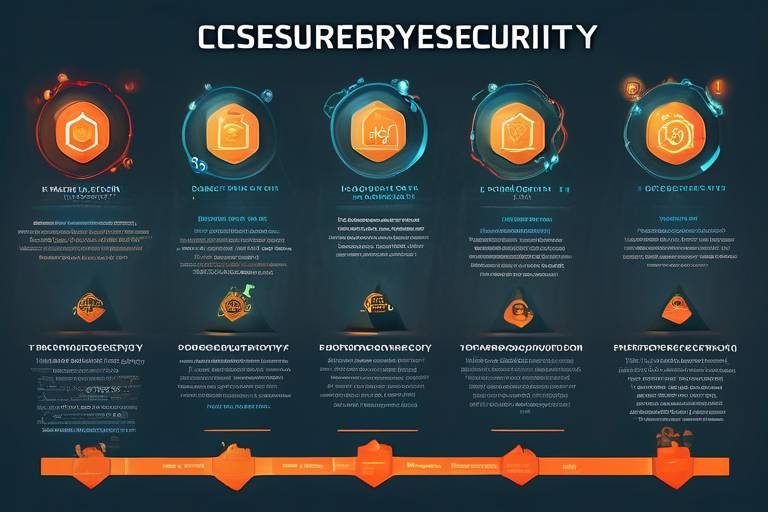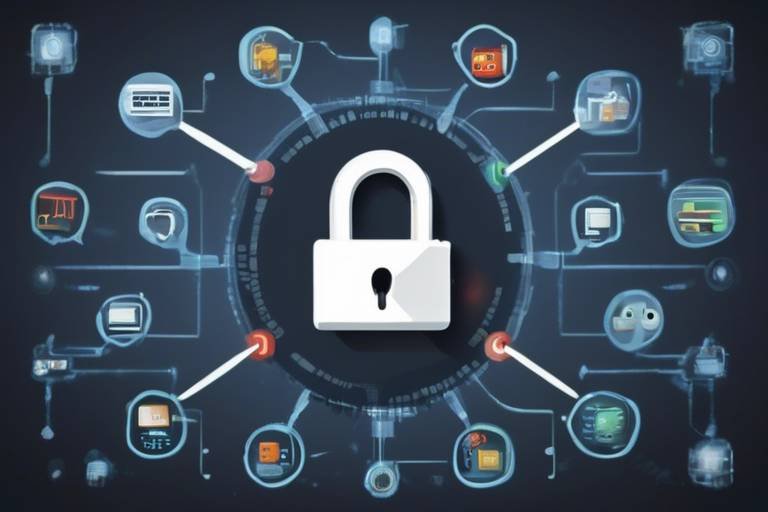Cybersecurity Challenges in the Age of the Internet
In today's hyper-connected world, where the internet is the backbone of our daily lives, the importance of cybersecurity cannot be overstated. As we embrace the digital age, we open ourselves up to a myriad of challenges that come with it. From personal data breaches to large-scale corporate hacks, the threats are as diverse as they are dangerous. It's a bit like walking through a beautiful garden filled with flowers; while the scenery is stunning, there are also hidden thorns that can prick you if you're not careful. The reality is that every click, every download, and every online transaction carries a risk, making it crucial for individuals and organizations to understand these challenges and take proactive measures to protect themselves.
One of the most alarming aspects of the current cybersecurity landscape is the rapid evolution of cyber threats. Gone are the days when a simple virus could wreak havoc; today's threats include sophisticated forms of malware like ransomware, which can lock users out of their own data until a ransom is paid, and advanced persistent threats (APTs), which are stealthy and often undetected for long periods. This constant evolution means that cybersecurity professionals must stay one step ahead, continuously adapting their strategies to combat new forms of attacks. It's akin to a game of chess, where every move must be calculated and anticipated, as the stakes are incredibly high.
Moreover, the role of artificial intelligence (AI) in cybersecurity is a double-edged sword. On one hand, AI technologies are revolutionizing how we detect and respond to threats, enabling faster and more accurate identification of anomalies in network traffic. Think of AI as a vigilant watchdog, constantly scanning for signs of trouble. However, on the flip side, cybercriminals are also harnessing the power of AI to launch more sophisticated attacks, making it a constant race between defenders and attackers. This arms race is a significant challenge in the cybersecurity landscape, as the tools that protect us can also be used against us.
In addition to technological challenges, we must consider the critical aspect of data privacy. With the rise of the internet, individuals are more vulnerable than ever to data breaches. Organizations must navigate a complex web of regulations, such as the General Data Protection Regulation (GDPR) and the California Consumer Privacy Act (CCPA), to ensure they protect user data. Failing to comply can result in hefty fines and devastating reputational damage. It's like walking a tightrope; one misstep can lead to a catastrophic fall.
Furthermore, the human factor in cybersecurity cannot be overlooked. Despite technological advancements, humans remain the weakest link in the security chain. A single careless click on a phishing link can compromise an entire organization. That's why implementing comprehensive training programs and fostering a culture of security awareness is vital. Employees should feel empowered to recognize threats and take action, much like being part of a team where everyone looks out for one another.
As we look to the future, it's clear that the landscape of cybersecurity will continue to evolve. Emerging technologies like quantum computing present both opportunities and challenges. While they promise to enhance data security, they also threaten to render traditional encryption methods obsolete. Organizations must remain agile, investing in innovative technologies and strategies to keep pace with the ever-changing threat landscape. In this ongoing battle, staying informed and prepared is key.
- What are the most common cybersecurity threats? The most common threats include ransomware, phishing attacks, and advanced persistent threats (APTs).
- How can organizations protect themselves from cyber threats? Organizations can protect themselves by implementing strong security protocols, conducting regular training for employees, and staying updated on the latest cybersecurity trends.
- What role does AI play in cybersecurity? AI enhances threat detection and response capabilities but can also be exploited by cybercriminals to automate attacks.
- Why is data privacy important? Data privacy is crucial to protect individuals' personal information and to comply with regulations that safeguard against data breaches.

Emerging Cyber Threats
In today's hyper-connected world, the digital landscape is constantly evolving, and with it, a myriad of that pose significant risks to individuals and organizations alike. As technology advances, so do the tactics employed by cybercriminals, making it imperative for us to stay informed and vigilant. One of the most alarming trends is the rise of ransomware, where attackers encrypt critical data and demand payment for its release. This type of malicious software has become increasingly sophisticated, targeting not only large corporations but also small businesses and even local governments.
Another prevalent threat is phishing, a deceptive technique used to trick individuals into revealing sensitive information such as passwords and credit card numbers. Phishing attacks have evolved from simple email scams to more elaborate schemes that can include fake websites and social media impersonations. These attacks often exploit human psychology, leveraging urgency or fear to compel victims to act quickly without thinking. For instance, a seemingly legitimate email from a bank could prompt a user to click on a link, leading them to a counterfeit site designed to harvest their credentials.
Moreover, the concept of advanced persistent threats (APTs) has gained traction in recent years. APTs are prolonged and targeted cyberattacks wherein an intruder gains access to a network and remains undetected for an extended period. These threats are often state-sponsored and aim to steal sensitive data or disrupt operations. Organizations must recognize that APTs are not just about immediate financial gain; they can also be part of a larger strategy to undermine national security or corporate stability.
To illustrate the variety of emerging threats, consider the following table that highlights some of the most common types of cyber threats today:
| Type of Threat | Description | Target |
|---|---|---|
| Ransomware | Malware that encrypts files and demands payment for decryption. | Businesses, individuals, government entities |
| Phishing | Fraudulent attempts to obtain sensitive information through deceptive communications. | Individuals, organizations |
| Advanced Persistent Threats (APTs) | Long-term targeted attacks aimed at stealing data or disrupting operations. | Corporations, governments |
| IoT Vulnerabilities | Exploiting weaknesses in Internet of Things devices to gain unauthorized access. | Home users, businesses |
As we navigate this complex digital landscape, it is crucial to understand that the fight against cyber threats is ongoing and requires a proactive approach. Organizations must invest in robust cybersecurity measures, including employee training, advanced security technologies, and incident response plans. By staying informed about these emerging threats, we can better prepare ourselves and our organizations to defend against the ever-evolving tactics of cybercriminals.

The Role of Artificial Intelligence
Artificial Intelligence (AI) is not just a buzzword; it’s a game-changer in the realm of cybersecurity. As we plunge deeper into the digital age, the need for robust security measures has never been more critical. AI is stepping up to the plate, offering innovative solutions that enhance our ability to detect and respond to cyber threats. Imagine having a vigilant guard that never sleeps, constantly monitoring for suspicious activity—that's the promise of AI in cybersecurity. But while it brings incredible advantages, it also introduces new challenges that we must navigate carefully.
One of the most significant ways AI is revolutionizing cybersecurity is through threat detection. Traditional security systems often rely on predefined rules to identify threats, which can leave gaps in protection. In contrast, AI algorithms can analyze vast amounts of data in real-time, identifying anomalies that may indicate a security breach. This capability allows organizations to react swiftly to potential threats, minimizing damage and reducing response times. For instance, if a user suddenly tries to access sensitive data from an unusual location, AI can flag this behavior as suspicious and alert the security team immediately.
AI-driven threat detection systems are becoming increasingly sophisticated. They utilize machine learning techniques to learn from historical data, adapting to new threats as they emerge. This means that the more data these systems process, the better they become at distinguishing between normal and malicious activities. In a world where cyber threats evolve rapidly, this adaptability is crucial. With AI, organizations can stay one step ahead of cybercriminals, predicting and preventing attacks before they occur.
Machine learning is at the heart of AI's effectiveness in cybersecurity. It enables systems to analyze patterns and recognize deviations from the norm. For example, if a company typically sees a specific amount of data traffic during business hours, an unexpected surge outside of these hours could trigger an alert. By continuously learning from new data, these systems can refine their algorithms, improving their accuracy over time. This dynamic learning process is akin to having a personal trainer who adjusts your workout based on your progress—always optimizing for better results.
Another significant advantage of AI is its ability to automate various security processes. This automation frees up valuable time for cybersecurity teams, allowing them to focus on strategic initiatives rather than getting bogged down with routine tasks. For instance, AI can automatically respond to detected threats, isolating affected systems and initiating predefined protocols without human intervention. This rapid response capability is essential in minimizing the impact of a cyber attack, much like a fire alarm that not only alerts you but also activates sprinklers to contain the flames.
However, it’s essential to recognize that AI is a double-edged sword. While it empowers organizations to bolster their defenses, cybercriminals are also harnessing AI to enhance their attacks. Automated tools can execute phishing campaigns at scale, making them more efficient and harder to detect. This arms race between defenders and attackers raises the stakes significantly. As cybersecurity professionals, we must remain vigilant and continuously adapt our strategies to counteract these evolving threats. The landscape is changing, and staying ahead requires not just technology but also a proactive mindset.
In summary, the integration of AI in cybersecurity is a double-edged sword, offering tremendous benefits in threat detection and response while also presenting new challenges. Organizations must embrace these technologies to enhance their security posture, but they must also remain aware of the potential for misuse. The future of cybersecurity will undoubtedly be shaped by AI, and those who adapt quickly will be the ones who thrive in this new digital landscape.
- What are the main benefits of using AI in cybersecurity? AI enhances threat detection, automates responses, and improves overall security efficiency.
- Can AI be used by cybercriminals? Yes, cybercriminals can leverage AI to automate attacks and make them more sophisticated.
- How does machine learning improve cybersecurity? Machine learning allows systems to learn from past data, adapting to new threats and improving detection accuracy.
- What role does automation play in cybersecurity? Automation helps streamline security processes, allowing teams to focus on strategic initiatives rather than routine tasks.

AI in Threat Detection
In today’s fast-paced digital world, the ability to detect threats in real-time is more critical than ever. Artificial Intelligence (AI) is emerging as a game-changer in this arena, revolutionizing how organizations identify and respond to potential cyber threats. Imagine having a vigilant digital watchdog that never sleeps, continuously analyzing vast amounts of data to spot anomalies that could signify a security breach. This is precisely what AI brings to the table.
AI algorithms are designed to sift through mountains of data, learning from patterns and behaviors that humans might overlook. By leveraging machine learning techniques, these algorithms can adapt and evolve, becoming smarter over time. This adaptability is crucial in a landscape where cyber threats are constantly morphing and becoming more sophisticated. For instance, if a system detects unusual login attempts from a specific geographical location, it can flag this activity for further investigation, potentially preventing a breach before it occurs.
Furthermore, the speed at which AI can process information is astonishing. Traditional methods of threat detection often rely on human analysis, which can be time-consuming and prone to errors. In contrast, AI can analyze data in seconds, providing security teams with timely insights that facilitate quicker decision-making. This rapid response capability is essential in mitigating risks and minimizing damage during a cyber incident.
To illustrate the impact of AI in threat detection, consider the following table that highlights key benefits:
| Benefit | Description |
|---|---|
| Real-Time Monitoring | AI systems can continuously monitor network activity, identifying threats as they occur. |
| Pattern Recognition | Machine learning algorithms can recognize patterns in data that indicate potential threats. |
| Reduced False Positives | AI can improve the accuracy of threat detection, reducing the number of false alarms. |
| Scalability | AI solutions can easily scale to handle increasing amounts of data without sacrificing performance. |
However, while AI significantly enhances threat detection capabilities, it’s essential to remember that it is not a silver bullet. The effectiveness of AI systems largely depends on the quality of the data they are trained on. Poor or biased data can lead to inaccurate predictions and missed threats. Therefore, continuous monitoring and refinement of AI models are necessary to ensure they remain effective in the face of evolving cyber threats.
In conclusion, AI is transforming the landscape of threat detection, offering organizations an unprecedented advantage in identifying and mitigating cyber risks. By harnessing the power of AI, businesses can not only enhance their security posture but also foster a proactive approach to cybersecurity that anticipates threats before they can cause harm.
- What is AI in threat detection? AI in threat detection refers to the use of artificial intelligence technologies to identify and respond to cyber threats in real-time.
- How does machine learning enhance threat detection? Machine learning enables systems to learn from historical data, improving their ability to recognize patterns and anomalies that indicate potential threats.
- What are the limitations of AI in cybersecurity? While AI is powerful, its effectiveness depends on the quality of data it is trained on, and it requires continuous monitoring and updates to remain effective.
- Can AI eliminate all cyber threats? No, AI cannot eliminate all threats, but it significantly improves the ability to detect and respond to them more quickly and accurately.

Machine Learning Techniques
Machine learning techniques are revolutionizing the way organizations approach cybersecurity. Imagine having a security system that not only reacts to threats but also learns from them. This is precisely what machine learning brings to the table. By analyzing vast amounts of historical data, these systems can identify patterns and anomalies that may indicate a potential security breach. It’s like having a vigilant guard who gets sharper with every incident, making it increasingly difficult for cybercriminals to succeed.
One of the most exciting aspects of machine learning in cybersecurity is its ability to adapt. Traditional security measures often rely on predefined rules and signatures to detect threats, which can leave gaps when new attacks emerge. In contrast, machine learning models can continuously evolve, learning from new data and adjusting their algorithms accordingly. This adaptability is crucial in an ever-changing digital landscape where cyber threats are constantly evolving.
To give you a clearer picture, let’s break down some key machine learning techniques commonly used in cybersecurity:
| Technique | Description |
|---|---|
| Supervised Learning | This technique involves training a model on a labeled dataset, allowing it to learn the relationship between input features and the corresponding output. It’s particularly useful for classifying known types of attacks. |
| Unsupervised Learning | Unlike supervised learning, this method deals with unlabeled data. It helps in identifying anomalies or unusual patterns that could signify a security threat. |
| Reinforcement Learning | This approach enables systems to learn optimal actions through trial and error, making it ideal for dynamic environments where threats can change rapidly. |
Moreover, machine learning techniques can significantly enhance threat detection systems. By employing algorithms that analyze user behavior, organizations can establish a baseline of normal activity. Any deviation from this baseline can trigger alerts, allowing security teams to respond swiftly. It’s akin to having a personal trainer who knows your routine so well that they can immediately spot when something is off.
In addition to anomaly detection, machine learning can also improve the accuracy of threat intelligence. By processing and correlating data from various sources, these systems can provide actionable insights, helping organizations prioritize their response efforts. This means less time spent sifting through irrelevant information and more time focusing on genuine threats.
However, it’s essential to recognize that while machine learning offers powerful tools for enhancing cybersecurity, it is not a silver bullet. Organizations must still invest in comprehensive security strategies that include human oversight, regular updates, and a robust incident response plan. Ultimately, the combination of machine learning with human expertise creates a formidable defense against the ever-evolving landscape of cyber threats.
- What is machine learning in cybersecurity? Machine learning in cybersecurity refers to the use of algorithms and statistical models to analyze and learn from data, enabling systems to detect and respond to threats more effectively.
- How does machine learning improve threat detection? By identifying patterns and anomalies in user behavior and system activity, machine learning algorithms can flag potential security incidents that may otherwise go unnoticed.
- Can machine learning completely eliminate cyber threats? No, while machine learning enhances cybersecurity measures, it cannot guarantee complete protection. A multi-layered security approach is still necessary.

AI-Driven Automation
In today's fast-paced digital landscape, is not just a buzzword; it is a game-changer for cybersecurity. Imagine a world where security teams are no longer bogged down by repetitive tasks, where they can focus on strategic initiatives that truly matter. That's the power of AI automation! By leveraging advanced algorithms, organizations can streamline their security processes, enhancing efficiency and response times. But how does this work in practice?
AI-driven automation utilizes sophisticated technologies to manage and analyze vast amounts of data, identifying potential threats faster than any human could. For instance, consider a scenario where a company receives thousands of alerts daily. Manually sifting through these alerts to identify genuine threats can be an overwhelming task. However, with AI automation, systems can prioritize alerts based on severity and likelihood, allowing security teams to concentrate on high-risk incidents. This not only improves the overall security posture but also empowers teams to allocate their resources more effectively.
Furthermore, AI-driven automation can integrate seamlessly with existing security frameworks. This integration allows for real-time monitoring and rapid response to emerging threats. For example, when a suspicious activity is detected, AI systems can automatically initiate predefined protocols, such as isolating affected systems or alerting security personnel, all without human intervention. This rapid response is crucial in minimizing damage during a cyber incident.
Here are some key benefits of AI-driven automation in cybersecurity:
- Efficiency: Automation reduces the time spent on routine tasks, freeing up human resources for more complex challenges.
- Accuracy: AI algorithms can analyze data with precision, reducing the risk of human error in threat detection.
- Scalability: As organizations grow, AI systems can easily scale to handle increased data and threat volume.
- Cost-Effectiveness: By automating routine tasks, organizations can reduce operational costs associated with cybersecurity.
However, it’s essential to recognize that while AI-driven automation enhances security, it is not a silver bullet. Organizations must remain vigilant and continuously update their systems and protocols to adapt to new threats. Cybercriminals are becoming increasingly sophisticated, and they are also leveraging AI to automate their attacks. This means that security teams must stay one step ahead, constantly evolving their strategies and technologies.
In conclusion, AI-driven automation is transforming the cybersecurity landscape by enhancing efficiency, accuracy, and response times. While it presents remarkable opportunities, organizations must remain proactive and adaptive to ensure their defenses are robust against the ever-evolving cyber threats.
- What is AI-driven automation in cybersecurity?
AI-driven automation refers to the use of artificial intelligence technologies to automate various cybersecurity processes, enhancing efficiency and threat response. - How does AI improve threat detection?
AI improves threat detection by analyzing large datasets in real-time, identifying anomalies, and prioritizing alerts based on severity. - Can AI-driven automation replace human security teams?
No, while AI can automate routine tasks, human oversight is still crucial for strategic decision-making and complex problem-solving. - What are the risks associated with AI in cybersecurity?
Cybercriminals can also use AI to enhance their attacks, making it essential for organizations to continuously adapt their defenses.

AI in Cybercrime
As the digital landscape evolves, so too do the tactics employed by cybercriminals. One of the most alarming trends is the increasing use of artificial intelligence in cybercrime. Just as AI is revolutionizing cybersecurity defenses, it is also being weaponized by malicious actors to enhance their attack strategies. Imagine a world where hackers can deploy sophisticated algorithms that learn from their previous attacks, adjusting in real-time to bypass security measures. This is not science fiction; it’s the reality we face today.
AI enables cybercriminals to automate various aspects of their operations, making them more efficient and difficult to detect. For instance, they can use AI-powered bots to launch phishing campaigns at a scale and speed that would be impossible for humans alone. These bots can analyze vast amounts of data to identify potential victims, crafting personalized messages that increase the likelihood of success. The result? A significant rise in the effectiveness of social engineering attacks.
Moreover, the use of machine learning algorithms allows cybercriminals to predict and exploit vulnerabilities in software and systems. By continuously analyzing patterns and behaviors, they can identify weak points before organizations even realize they exist. This proactive approach to cybercrime means that businesses must stay one step ahead, constantly evolving their defenses to combat these increasingly sophisticated threats.
Here are some notable ways AI is being used in cybercrime:
- Automated Attack Tools: Cybercriminals can deploy AI-driven tools that automate attacks, making it easier to launch large-scale campaigns without the need for extensive manpower.
- Deepfake Technology: Advanced AI can create realistic deepfake videos and audio, which can be used for fraud or to manipulate individuals into divulging sensitive information.
- Data Mining: AI algorithms can sift through massive datasets to identify personal information, making it easier for criminals to carry out identity theft or financial fraud.
The implications of AI in cybercrime are profound. As organizations invest in AI to bolster their defenses, they must also be aware of the potential for these same technologies to be turned against them. The arms race between cybersecurity professionals and cybercriminals is intensifying, and the stakes have never been higher. To combat these threats, businesses must adopt a multi-layered security approach that includes not only advanced technologies but also comprehensive training and awareness programs for their employees.
In conclusion, while AI offers tremendous potential for enhancing cybersecurity, it also presents new challenges that must be addressed. Organizations cannot afford to be complacent; they must remain vigilant and proactive in their defense strategies. The future landscape of cybercrime will undoubtedly be shaped by how well we adapt to these evolving threats.
Q: How is AI used in cybercrime?
A: Cybercriminals use AI to automate attacks, analyze vulnerabilities, and craft personalized phishing messages, making their efforts more efficient and harder to detect.
Q: What can organizations do to protect themselves from AI-driven cybercrime?
A: Organizations should invest in advanced cybersecurity technologies, conduct regular training for employees, and implement a multi-layered security approach to defend against evolving threats.
Q: Are there any regulations that address the use of AI in cybercrime?
A: While there are various regulations concerning data protection and privacy, specific regulations targeting the malicious use of AI in cybercrime are still developing and may vary by region.

Data Privacy Concerns
In today's digital age, data privacy has become a pressing concern for individuals and organizations alike. With the exponential growth of the internet, personal and sensitive information is more accessible than ever, making it a prime target for cybercriminals. The challenge lies not only in protecting this data but also in navigating the complex landscape of regulations designed to safeguard user privacy. As we delve deeper into this topic, it's essential to understand the implications of data breaches and the measures organizations must take to protect user information.
One of the most significant challenges organizations face is compliance with various data protection regulations. Laws such as the General Data Protection Regulation (GDPR) and the California Consumer Privacy Act (CCPA) impose strict guidelines on how companies collect, store, and manage personal data. Failing to comply with these regulations can result in hefty fines and damage to an organization's reputation. For instance, under GDPR, companies can face fines of up to €20 million or 4% of their annual global revenue, whichever is higher. This highlights the importance of understanding these regulations and implementing necessary measures to ensure compliance.
Moreover, the consequences of a data breach can be catastrophic. Organizations that experience a breach often face not only financial losses but also a significant hit to their reputation. Customers are becoming increasingly aware of their data rights, and a breach can lead to a loss of trust that is difficult to rebuild. The repercussions can extend beyond immediate financial impacts, leading to legal ramifications and long-term damage to brand credibility. For example, the infamous data breach of Equifax in 2017 affected approximately 147 million people and resulted in over $4 billion in total costs, including fines and settlements.
To mitigate these risks, organizations must adopt robust data protection strategies. This includes implementing advanced security measures such as encryption, multi-factor authentication, and regular security audits. Additionally, fostering a culture of data privacy within the organization is crucial. Employees should be trained on best practices for handling sensitive information and understanding the importance of data protection. By prioritizing data privacy, organizations can not only comply with regulations but also build trust with their customers.
In conclusion, as we navigate the complexities of the digital landscape, data privacy remains a critical concern. Organizations must stay informed about regulatory requirements and invest in comprehensive data protection strategies to safeguard user information. The stakes are high, and the cost of inaction can be devastating. By taking proactive measures, businesses can protect themselves and their customers in an increasingly interconnected world.
- What is data privacy? Data privacy refers to the proper handling, processing, storage, and usage of personal information, ensuring that individuals have control over their own data.
- Why is data privacy important? Data privacy is crucial to protect individuals from identity theft, fraud, and unauthorized access to their personal information, as well as to maintain trust between customers and organizations.
- What are the main data protection regulations? The main data protection regulations include the General Data Protection Regulation (GDPR) in the EU and the California Consumer Privacy Act (CCPA) in the USA.
- What can organizations do to protect user data? Organizations can implement security measures such as encryption, regular audits, and employee training to safeguard user data and ensure compliance with regulations.

Regulatory Compliance
In today's digital landscape, has become a cornerstone for organizations aiming to protect user data and maintain trust. With laws like the General Data Protection Regulation (GDPR) in Europe and the California Consumer Privacy Act (CCPA) in the United States, companies are now obligated to adhere to strict guidelines regarding data handling, storage, and privacy. Failing to comply with these regulations can lead to hefty fines and significant reputational damage, making it essential for organizations to stay informed and proactive in their compliance efforts.
Understanding the intricacies of these regulations is no small feat. For instance, GDPR mandates that organizations must obtain explicit consent from users before collecting their data, while also providing them with the right to access, modify, or delete their information. Similarly, CCPA empowers consumers to know what personal data is being collected about them and to whom it is being sold. This shift towards greater transparency and user control has pushed companies to rethink their data practices.
To effectively navigate the regulatory landscape, organizations can implement a compliance framework that includes several key components:
- Data Mapping: Understanding what data is collected, where it is stored, and how it flows through the organization.
- Regular Audits: Conducting routine audits to ensure compliance with regulations and to identify potential vulnerabilities.
- Employee Training: Educating staff on compliance requirements and the importance of data protection to foster a culture of security.
- Incident Response Plan: Developing a robust plan to address data breaches promptly and effectively.
Moreover, organizations must remain vigilant as regulations evolve. For example, recent discussions around enhancing privacy laws in various jurisdictions suggest that the compliance landscape will continue to change. This means that companies need to be agile, adapting their policies and practices to meet new requirements as they arise.
In conclusion, regulatory compliance is not just a box to check; it's a fundamental aspect of building a trustworthy relationship with users. By prioritizing compliance, organizations can not only avoid penalties but also enhance their reputation and customer loyalty in an increasingly competitive market.
- What is GDPR? GDPR stands for General Data Protection Regulation, a comprehensive data protection law in the EU that governs how personal data is collected and processed.
- What are the consequences of non-compliance? Organizations that fail to comply with regulations like GDPR and CCPA can face heavy fines, legal action, and damage to their reputation.
- How can organizations ensure compliance? By implementing a compliance framework, conducting regular audits, and providing employee training, organizations can better ensure adherence to regulations.

Data Breach Consequences
In today's digital age, a data breach can feel like a ticking time bomb, ready to explode at any moment. The consequences of such breaches can be devastating, not only for the organizations involved but also for the individuals whose data is compromised. Imagine waking up one day to find that your personal information has been leaked, your identity stolen, or your financial details exposed. These scenarios are no longer the stuff of nightmares; they are a reality faced by many.
One of the most immediate consequences of a data breach is financial loss. Organizations can incur hefty costs related to legal fees, regulatory fines, and the expenses associated with notifying affected individuals. According to recent studies, the average cost of a data breach can reach millions of dollars. Additionally, businesses may need to invest in enhanced security measures to prevent future breaches, which can further strain their financial resources.
Beyond financial implications, breaches can lead to severe reputational damage. Trust is a fragile thing, and once it's broken, it can take years to rebuild. Customers may lose faith in a company's ability to protect their data, leading to decreased sales and a tarnished brand image. For instance, companies like Equifax and Target faced significant backlash after data breaches, resulting in a loss of customer loyalty that they are still working to recover from.
Moreover, the legal ramifications of a data breach can be daunting. Organizations may face lawsuits from affected individuals or regulatory bodies, leading to further financial strain and potential settlements. The legal landscape surrounding data privacy is becoming increasingly complex, with regulations like GDPR and CCPA imposing strict penalties for non-compliance. This means that organizations must not only focus on preventing breaches but also ensure they are compliant with these regulations to avoid additional repercussions.
To illustrate the potential consequences of a data breach, consider the following table that summarizes key impacts:
| Consequence | Description |
|---|---|
| Financial Loss | Costs associated with legal fees, fines, and security improvements. |
| Reputational Damage | Loss of customer trust and potential decrease in sales. |
| Legal Ramifications | Possible lawsuits and penalties from regulatory bodies. |
In addition to these direct consequences, there are also long-term effects on employee morale and productivity. When a breach occurs, employees may feel anxious about the security of their own data and the company’s ability to protect sensitive information. This anxiety can lead to decreased productivity and a lack of confidence in the organization's leadership, further complicating the recovery process.
Ultimately, the consequences of a data breach extend far beyond the immediate aftermath. Organizations must recognize the importance of implementing robust security measures and fostering a culture of cybersecurity awareness. By taking proactive steps to protect sensitive data, businesses can mitigate the risks associated with data breaches and safeguard their reputation in an increasingly digital world.
- What is a data breach? A data breach occurs when unauthorized individuals gain access to sensitive, protected, or confidential data.
- What are the common causes of data breaches? Common causes include hacking, phishing attacks, insider threats, and inadequate security measures.
- How can organizations prevent data breaches? Organizations can prevent breaches by implementing strong security protocols, conducting regular training, and staying compliant with data protection regulations.
- What should individuals do if their data is compromised? Individuals should monitor their accounts for suspicious activity, change passwords, and consider enrolling in identity theft protection services.

Human Factor in Cybersecurity
When we talk about cybersecurity, it’s easy to get lost in the technical jargon and the latest software solutions. However, the truth is that the **human factor** often represents the most vulnerable point in the security chain. Think about it: no matter how sophisticated your firewall is or how advanced your AI threat detection system may be, if a human makes a mistake, all that technology can be rendered useless. It's like having the strongest castle walls, yet leaving the gates wide open. This is why understanding the human element in cybersecurity is crucial.
One of the primary issues is that many employees lack awareness of cybersecurity risks. They might be well-versed in their job roles, but when it comes to recognizing a phishing email or understanding the importance of strong passwords, they often fall short. For instance, a recent study revealed that **over 90% of successful cyberattacks** are attributed to human error. This statistic alone underscores the need to focus on training and awareness programs within organizations.
To tackle this issue, companies can implement comprehensive training programs that cover various aspects of cybersecurity. These programs should not only educate employees on the latest threats but also provide practical strategies for mitigating risks. Here are some key components that should be included in such training:
- Phishing Awareness: Teach employees how to identify phishing attempts, which are often disguised as legitimate emails from trusted sources.
- Password Security: Encourage the use of strong, unique passwords and the importance of changing them regularly.
- Incident Reporting: Create a culture where employees feel comfortable reporting suspicious activities without fear of repercussions.
Moreover, building a **security culture** within the organization is essential. This means making cybersecurity a core value that permeates every level of the company. When employees understand that they play a vital role in protecting sensitive information, they are more likely to adopt secure practices in their daily activities. It’s akin to being part of a team where everyone has a shared goal; when one person scores, the whole team benefits.
Another critical aspect is addressing **insider threats**. These can come from disgruntled employees or even those who inadvertently expose sensitive data. Organizations need to be vigilant and implement measures such as regular audits and monitoring systems to detect unusual behavior. This doesn't mean creating a culture of distrust, but rather fostering an environment where everyone is aware of their responsibilities regarding data security.
In conclusion, while technology plays a significant role in cybersecurity, the human factor cannot be overlooked. By investing in training, fostering a culture of security, and addressing insider threats, organizations can significantly enhance their cybersecurity posture. After all, the most robust security measures are only as effective as the people using them.
| Question | Answer |
|---|---|
| What is the human factor in cybersecurity? | The human factor refers to the role that people play in cybersecurity, including their behaviors, decisions, and actions that can either strengthen or weaken security measures. |
| How can organizations improve employee awareness of cybersecurity? | Organizations can implement training programs that focus on identifying threats, secure password practices, and incident reporting to improve employee awareness. |
| What are insider threats? | Insider threats come from individuals within the organization who may intentionally or unintentionally compromise security, often due to negligence or malicious intent. |

Phishing Awareness Training
In today's digital world, phishing attacks are more prevalent than ever, targeting unsuspecting individuals and organizations alike. Phishing is a deceptive tactic where cybercriminals masquerade as trustworthy entities to trick victims into revealing sensitive information, such as passwords or credit card numbers. This is where comes into play. It's not just a nice-to-have; it's a necessity for any organization that values its data and its people.
So, what does phishing awareness training entail? At its core, it aims to educate employees about the various forms of phishing attacks, helping them recognize suspicious emails, links, and websites. Training sessions often include real-life examples and interactive exercises that simulate phishing attempts, allowing employees to practice identifying threats in a safe environment. This hands-on approach not only makes the training engaging but also reinforces the learning experience, increasing the chances that employees will remember the lessons when faced with real attacks.
Additionally, organizations can implement a multi-faceted training program that covers several key areas:
- Types of Phishing: Employees should learn about different phishing methods, including spear phishing, whaling, and vishing (voice phishing). Understanding these variations can help them identify threats more effectively.
- Red Flags: Training should highlight common signs of phishing attempts, such as poor grammar, generic greetings, and urgent calls to action. Recognizing these red flags is crucial for preventing successful attacks.
- Reporting Procedures: Employees should know how to report suspected phishing attempts within the organization. This encourages a culture of vigilance and ensures that potential threats are addressed promptly.
Moreover, phishing awareness training is not a one-time event. Cyber threats evolve rapidly, and so should the training programs. Regular updates and refresher courses can help keep employees informed about the latest phishing tactics and techniques. This ongoing education helps cultivate a security-conscious workforce, reducing the likelihood of falling victim to cybercriminals.
To further enhance the effectiveness of phishing awareness training, organizations can consider implementing simulated phishing campaigns. These campaigns involve sending fake phishing emails to employees to assess their responses. Such simulations provide valuable insights into how well employees can identify phishing attempts and help identify areas where additional training may be needed.
Ultimately, investing in phishing awareness training is one of the most effective strategies organizations can adopt to bolster their cybersecurity defenses. By empowering employees with knowledge and skills, organizations can significantly reduce their vulnerability to phishing attacks. It's about creating a security culture where everyone is vigilant, informed, and ready to act. In this digital age, where cyber threats are constantly evolving, can we really afford to ignore the importance of phishing awareness?
- What is phishing? Phishing is a cyber attack that uses deceptive emails or websites to trick individuals into revealing sensitive information.
- How can I recognize a phishing attempt? Look for poor grammar, generic greetings, and urgent requests for personal information as common signs of phishing.
- Is phishing awareness training effective? Yes, it significantly reduces the likelihood of employees falling victim to phishing attacks by educating them about potential threats.
- How often should phishing awareness training be conducted? Regular training sessions and updates are recommended to keep employees informed about evolving phishing tactics.

Building a Security Culture
In today's digital world, where cyber threats lurk around every corner, building a security culture within an organization is not just a luxury; it's a necessity. But what does this really mean? Think of it like creating a fortress. You wouldn’t just build tall walls and call it a day. You need to ensure that everyone inside the fortress—your employees—understands their role in keeping it secure. A strong security culture fosters an environment where every team member feels responsible for protecting sensitive information and recognizing potential threats.
To establish this culture, organizations must prioritize training and awareness programs. Imagine teaching your employees to be the eyes and ears of your security system. Regular training sessions can empower them to identify phishing attempts, suspicious emails, or unusual activities. When employees are educated about the latest cyber threats, they become the first line of defense. For instance, a study found that companies with robust training programs saw a 70% decrease in successful phishing attacks. That's not just numbers; that's real protection!
Moreover, creating a culture of security goes beyond just training. It involves integrating security practices into the daily routines of employees. This can be achieved by:
- Encouraging open discussions about cybersecurity during team meetings.
- Recognizing and rewarding employees who demonstrate strong security practices.
- Implementing policies that promote secure behavior, such as password management and data handling.
Another critical aspect is leadership involvement. When leaders prioritize cybersecurity, it sends a clear message that security is vital to the organization's success. Leaders should lead by example, adopting secure practices themselves and actively participating in training sessions. This not only boosts morale but also reinforces the idea that cybersecurity is everyone's responsibility. Think of it like a sports team; when the coach is engaged and practices with the team, everyone plays better.
Finally, it’s essential to continuously assess and refine your security culture. Regular feedback from employees can provide insights into potential weaknesses in your training programs or policies. By fostering an environment of continuous improvement, organizations can adapt to the ever-changing landscape of cyber threats. Remember, cybersecurity is not a one-time effort; it’s an ongoing journey. Just as technology evolves, so too must your security culture.
- What is a security culture? A security culture refers to the collective attitudes, values, and practices of an organization towards cybersecurity, emphasizing the importance of security in daily operations.
- Why is training important for building a security culture? Training empowers employees to recognize threats and understand their role in maintaining security, significantly reducing the risk of breaches.
- How can leadership influence security culture? Leadership sets the tone for the organization. When leaders prioritize and model secure behaviors, it encourages employees to do the same.
- What are some ways to maintain a strong security culture? Regular training, open communication, employee recognition, and continuous assessment are key to maintaining a robust security culture.

Future Trends in Cybersecurity
As we look towards the horizon of technology, it's clear that the landscape of cybersecurity is evolving at an unprecedented pace. The future of cybersecurity is not just about defending against existing threats; it's about anticipating and preparing for the challenges that lie ahead. One significant trend is the rise of quantum computing. This breakthrough technology promises to deliver processing power that far exceeds our current capabilities, potentially revolutionizing how we protect sensitive information. However, it also poses a serious threat to traditional encryption methods, making it essential for cybersecurity professionals to rethink their strategies.
Moreover, the adoption of artificial intelligence and machine learning will continue to shape the cybersecurity landscape. These technologies not only enhance threat detection but also automate responses to incidents, allowing organizations to respond to threats faster than ever before. Imagine an AI system that can analyze vast amounts of data in real-time, identifying anomalies and flagging potential threats before they escalate. This level of proactive security is becoming a reality, but it also raises the stakes; as defenders become more sophisticated, so too do the tactics employed by cybercriminals.
Another crucial aspect of future cybersecurity trends is the increasing importance of data privacy. With regulations like GDPR and CCPA becoming more stringent, organizations must prioritize compliance to protect user data. Failure to adhere to these regulations can result in hefty fines and irreparable damage to an organization's reputation. As such, businesses will need to invest in robust data governance frameworks that not only ensure compliance but also foster trust with their customers.
Additionally, the human factor remains a critical element in the cybersecurity equation. Despite technological advancements, humans often represent the weakest link in the security chain. Therefore, organizations must focus on building a strong security culture that empowers employees to take an active role in protecting sensitive information. This includes regular training sessions on recognizing phishing attempts and understanding the importance of data privacy. By fostering a culture of security awareness, organizations can significantly reduce the risk of human error leading to security breaches.
Finally, as we adapt to these emerging trends, organizations must remain agile and flexible. The cyber threat landscape is constantly changing, and what works today may not be effective tomorrow. Companies will need to invest in innovative technologies and strategies to stay ahead of cybercriminals. This could involve adopting new security frameworks, conducting regular risk assessments, and engaging in continuous learning to keep pace with the evolving threats.
- What is quantum computing and how does it impact cybersecurity?
Quantum computing refers to a new type of computing that leverages the principles of quantum mechanics. It has the potential to break traditional encryption methods, necessitating the development of new security protocols. - How can organizations prepare for future cybersecurity threats?
Organizations can prepare by investing in advanced security technologies, fostering a culture of security awareness among employees, and staying informed about the latest cyber threats and trends. - Why is the human factor crucial in cybersecurity?
The human element is often the weakest link in security. Training employees to recognize threats and prioritize security can significantly reduce the risk of breaches caused by human error.

Quantum Computing Implications
Quantum computing is often hailed as the next frontier in technology, promising to revolutionize industries and solve complex problems at lightning speed. But what does this mean for cybersecurity? As we stand on the brink of this technological leap, it's essential to understand both the opportunities and the challenges that quantum computing brings to the cybersecurity landscape.
At its core, quantum computing utilizes the principles of quantum mechanics, enabling computers to process information in ways that classical computers cannot. This means that tasks that would take traditional computers thousands of years to complete could potentially be done in seconds. However, this unprecedented processing power also poses a significant threat to current encryption methods, which rely on the difficulty of certain mathematical problems to keep data secure.
For instance, many encryption algorithms, such as RSA and ECC, depend on the computational difficulty of factoring large numbers or solving discrete logarithms. Quantum computers, utilizing algorithms like Shor's algorithm, could easily break these encryption schemes, rendering sensitive data vulnerable to cybercriminals. In this new reality, organizations must take proactive measures to safeguard their information.
To better illustrate the implications of quantum computing on cybersecurity, consider the following table:
| Encryption Method | Current Security Level | Quantum Vulnerability |
|---|---|---|
| RSA | High | Breakable in polynomial time |
| Elliptic Curve Cryptography (ECC) | High | Breakable in polynomial time |
| Symmetric Key Algorithms (AES) | Moderate | Reduced effectiveness |
This table highlights how traditional encryption methods may become obsolete in the face of quantum computing advancements. As a result, organizations must begin to explore quantum-resistant algorithms and strategies to protect their data. This shift requires a comprehensive understanding of both quantum technology and cybersecurity principles.
Moreover, the implications of quantum computing extend beyond just breaking encryption. The emergence of quantum networks could also change the way we approach data security. Quantum key distribution (QKD) promises to offer a method of secure communication that is theoretically immune to eavesdropping. By using the principles of quantum mechanics, QKD allows two parties to share a secret key securely, making it nearly impossible for a third party to intercept the communication without detection.
However, implementing quantum technologies poses its own set of challenges, including:
- Infrastructure Requirements: Developing the necessary infrastructure for quantum communication is complex and expensive.
- Standardization: The lack of standardized protocols for quantum communication can hinder widespread adoption.
- Skill Gap: There is a significant need for professionals skilled in both quantum computing and cybersecurity.
In conclusion, as we venture into the age of quantum computing, organizations must remain vigilant and proactive. Understanding the implications of this technology is crucial for developing effective cybersecurity strategies. By investing in quantum-resistant encryption methods and exploring innovative solutions like quantum key distribution, we can better prepare for the challenges ahead. The future of cybersecurity will undoubtedly be shaped by our ability to adapt to these advancements, and the time to act is now.
- What is quantum computing? Quantum computing is a type of computation that uses quantum bits (qubits) to perform calculations at speeds much faster than traditional computers.
- How does quantum computing affect cybersecurity? Quantum computing threatens traditional encryption methods, potentially making sensitive data vulnerable to cyberattacks.
- What are quantum-resistant algorithms? These are cryptographic algorithms designed to be secure against the capabilities of quantum computers.
- What is quantum key distribution (QKD)? QKD is a secure communication method that uses quantum mechanics to distribute encryption keys, ensuring that any eavesdropping is detectable.

Adapting to Evolving Threats
In a world where cyber threats are as dynamic as the technology that fuels them, is not just a strategy; it's a necessity. Organizations must be like chameleons, constantly changing their colors to blend into a landscape that is perpetually shifting. The rise of sophisticated attacks means that yesterday's defenses might not be enough to thwart today's cybercriminals. So, how can businesses ensure they are not left in the dust?
First and foremost, embracing a culture of continuous learning and adaptation is crucial. Cybersecurity is not a one-time effort; it requires ongoing vigilance and the willingness to change. Organizations should invest in regular training sessions that keep employees informed about the latest threats and tactics used by cybercriminals. This includes understanding the nuances of phishing attacks, recognizing social engineering tactics, and being aware of the latest malware trends.
Moreover, leveraging technology is key to staying ahead. Advanced security solutions powered by artificial intelligence and machine learning can analyze vast amounts of data in real-time, identifying patterns that may indicate a potential threat. For instance, AI-driven systems can detect unusual behavior within a network, flagging it for immediate investigation. This proactive approach allows organizations to respond swiftly to potential breaches before they escalate into full-blown crises.
Additionally, organizations should regularly update their security protocols and software. Cybercriminals are constantly evolving their tactics, and outdated defenses can be a significant vulnerability. Implementing a robust patch management strategy is essential for ensuring that all systems are up-to-date and fortified against known vulnerabilities.
Furthermore, it’s vital to develop an incident response plan that can be activated in the event of a breach. This plan should outline clear steps for containment, eradication, and recovery, ensuring that every team member knows their role in the event of an attack. A well-prepared organization can significantly reduce the impact of a cyber incident, minimizing downtime and protecting sensitive data.
Lastly, collaboration with external cybersecurity experts can provide an additional layer of defense. Engaging with third-party security firms can help organizations gain insights into emerging threats and best practices for mitigation. These partnerships can also facilitate penetration testing and vulnerability assessments, identifying weaknesses before they can be exploited.
In summary, adapting to evolving threats is about more than just technology; it's about cultivating a mindset that prioritizes security at every level of the organization. By fostering a culture of continuous improvement, leveraging advanced technologies, updating protocols, preparing for incidents, and collaborating with experts, businesses can navigate the turbulent waters of cybersecurity with confidence.
- What are the most common types of cyber threats? Ransomware, phishing, and advanced persistent threats are among the most common.
- How can organizations train employees on cybersecurity? Regular training sessions, simulated phishing attacks, and awareness programs can help.
- Why is AI important in cybersecurity? AI enhances threat detection and response times, making it easier to identify anomalies.
- What should a cybersecurity incident response plan include? It should outline steps for containment, eradication, and recovery.
- How often should security protocols be updated? Regular updates should be made, ideally on a monthly or quarterly basis, depending on the threat landscape.
Frequently Asked Questions
- What are the most common cyber threats today?
Some of the most common cyber threats include ransomware, which locks users out of their data until a ransom is paid, and phishing, where attackers trick individuals into providing sensitive information. Additionally, advanced persistent threats (APTs) are becoming increasingly sophisticated, targeting organizations over long periods.
- How is artificial intelligence changing cybersecurity?
Artificial intelligence (AI) is revolutionizing cybersecurity by enabling faster and more accurate threat detection. AI algorithms can analyze vast amounts of data in real-time to identify anomalies, allowing security teams to respond swiftly to potential threats. However, it's a double-edged sword, as cybercriminals are also using AI to enhance their attacks.
- What should organizations do to protect user data?
Organizations need to implement robust data protection strategies, including adhering to regulations like GDPR and CCPA. Regularly updating security measures, conducting audits, and providing employee training on data privacy are crucial steps to safeguard user data from breaches.
- Why is the human factor significant in cybersecurity?
The human factor is often considered the weakest link in cybersecurity. Many breaches occur due to human error, such as falling for phishing scams. Therefore, training and awareness programs are vital to educate employees about potential threats and to foster a culture of security within organizations.
- What are the implications of quantum computing for cybersecurity?
Quantum computing has the potential to drastically change the cybersecurity landscape. While it offers incredible processing power that can enhance security measures, it also poses risks to traditional encryption methods, making it essential for organizations to adapt their security strategies accordingly.
- How can organizations stay ahead of evolving cyber threats?
To stay ahead of evolving cyber threats, organizations must remain agile and continuously invest in innovative technologies and strategies. This includes regularly updating security protocols, conducting threat assessments, and fostering a proactive security culture among employees.



















